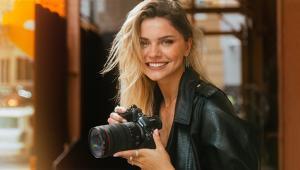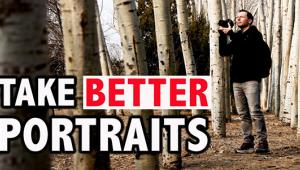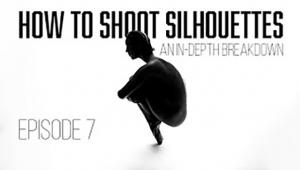Character Studies: How Brian Ingram Captures His Pensive and Powerful Portraits

Ingram was commissioned to shoot a portrait of Shannon Johnston, a U.S. Marine who was one of the first boots on the ground in Iraq in 2003 and aided in the rescue of POW Jessica Lynch. Ingram used a heavily flagged, gridded beauty dish positioned high, from the right, as the key light, and behind camera, to the right, a seven-foot Octa as fill. He added a gridded strobe on the custom-painted backdrop for separation.
All Photos © Brian Ingram
Disillusioned with the practice of law, Brian Ingram found himself forced to reexamine his professional path in life. So, at a critical juncture, Ingram chose what to him was the road “less traveled by.” And, to further quote Robert Frost’s poem “The Road Not Taken,” it “has made all the difference.” Sparked by the gift of a Nikon D40, Ingram chose photography to be his new profession, and this new path revitalized his outlook on life.

The lighting here involved a shoot-through umbrella, about a foot above head height, and heavily flagged on both sides, with a silver reflector held close to the body to pop some light up into the shadows. “I wanted enough light, even after flagging, so you could see the playing card in his hat, which the performer specifically asked to be evident in his album packaging.”

Ingram shot this portrait on the family horse farm. He augmented the natural light with one light from the left, positioned very low.
The Road Taken
Choosing photography as a career is one thing, finding your niche is quite another. A galaxy of possibilities baffled Ingram, but one day he found his shooting star. It came in the form of his niece Abigail, who at the time was battling anorexia. The family was spending Thanksgiving at a cabin in the Smoky Mountains. Seeing her sitting on the porch, he asked to take her picture. She agreed. And that shot formed the Big Bang in his career, earning him first prize in a photo competition that he’d entered. He has since garnered a broad clientele.
With the dawning realization that he’d found his new passion, Ingram gradually upgraded his gear to include both a medium format system and a full-frame DSLR. Ingram now shoots both digital and film; film allows him to indulge his more artistic side. With the aid of a tightly calibrated Eizo monitor, he edits using Phase One’s Capture One Pro, Adobe’s Photoshop and Lightroom, and Hasselblad’s Phocus.

This portrait of his niece represents a central moment that helped launch Ingram’s career. He later went on to document her successful battle with anorexia. This was shot by natural light outdoors.

To emphasize that his niece was in recovery, Ingram used a 24mm lens to show her improving health. For this studio shot, he used a shoot-through umbrella with a flag, positioning her against a black duvateen backdrop.
A Synthesized Approach to Lighting
Ingram has had several influences on his shooting style in his formative days. “Yousuf Karsh was one of the biggest influences on my work in the beginning,” he recalled. “Other portrait photographers who have influenced me are Dan Winters, Sally Mann, and, to some degree, Irving Penn.”
Ingram especially found Karsh’s approach to his subjects inspiring, the way the master portraitist expressed a reverence for them, interacting with them, and bringing them out of their shell. What’s more, Ingram added, “With just about every successful portrait photographer, I’ve noticed that they possess an innate sense or instinct of how far they can push a subject, and when to put on the brakes.”
It wasn’t just a matter of attitude that left its mark on Ingram. Lighting techniques played a strong role, specifically pointing to Karsh. That said, Ingram isn’t a slave to the lighting techniques of the masters. He does have his own spin on things. “When it comes to lighting, my belief is that it is okay to emulate photographers you admire. Then you should take all those different approaches and synthesize your own style of lighting, which is what I did.”
When asked to define his lighting style, Ingram responded: “Simple. That’s the first word that comes to mind. A lot of my portraits are made with one or two lights. They involve one strong key light, often a gridded silver beauty dish or maybe a medium Octa with only the internal baffle attached, and a lot of flagging to shape the light and to control exactly where I want the light to fall, with an emphasis always on highlighting or defining the face.” He’ll sometimes also throw in a collapsible silver reflector, if needed. Ingram added that “for a lot of my portraits, especially when using a gridded beauty dish, I’ll also use a seven-foot Octa behind me to add a bit of fill in the shadows, and maybe a light on the backdrop for separation between subject and background.”

For a personal project focusing on U.S. vets from World War II to Iraq, Ingram photographed this Vietnam veteran at his assisted-living residence. Lighting came from a gridded beauty dish positioned very high and to the right, with a bare head bounced off the ceiling for a subtle fill.

“Many view this shot as styled after Yousuf Karsh’s portrait of Hemingway, although I see it more in the style of Irving Penn.” Brian Ingram essentially built a black box for the subject from duvateen and employed a shoot-through umbrella with heavy flagging.
Posing Without Posing
Ingram often has his subjects looking meditative or directing their gaze anywhere but into the lens. “The way I shoot is somewhat conversational. I don’t do a lot of talking, but often I’ll have my assistants to the left and right of me talk to the subject, distracting that person in one direction or another, in order to make a more natural and organic portrait. Having said that, it depends on the subject and style or direction of the shoot. Sometimes, looking more into the lens works best.”
Many of Ingram’s portraits are shot in his own studio, without the aid of assistants. When going one-on-one with a subject, he’s developed a knack for establishing rapport “by being myself. Talking to them, getting them talking. Sometimes I get a difficult subject, so I start asking them about themselves—that’s the biggest thing. If you show interest in someone else, instead of interrupting and trying to talk about yourself, very often you can bring out the true nature of that individual. And then there are times when I’ll just have some quiet moments. It’s a dance really, and the hardest part is finding that rhythm that works with your subject.”
Pursuing portrait photography as a career has given Brian Ingram a new lease on life. He has imbued his portraits with added depth and dimension thanks to his lighting and the way he approaches each portrait subject. He treats each person as an individual with a story to tell, even if just with a telling glance or a turn of the head.

Ingram created this portrait, inspired by the work of various photographers, giving it his own spin with a custom-painted backdrop. He wanted the backdrop to look like an oil-stained drop cloth. The light on the backdrop was gridded to prevent spill. On her face is a gridded beauty dish, with a snooted light to emphasize the hands.
What’s in Ingram’s Gear Bag
* Hasselblad H5D-60 with Hasselblad 80mm f/2.8 lens
* Nikon D810 with battery grip and Sigma Art 35mm and 50mm, and Nikkor 85mm f/1.8 lenses
* Mamiya RZ67 Pro II with Mamiya 140mm f/4.5 Macro lens and Mamiya 110mm f/2.8 lens
* Sekonic L-478 light meter
* At least three to four extra batteries for each body, with chargers
* At least nine memory cards (usually 8 to 16GB each)
* Gray card
* Pelican roller case
* Profoto lighting (Profoto D1 Air 500, D1 Air 1000, Acute2)
* Wireless triggers (Profoto Air Remote and PocketWizard)

Ingram’s Favorite Gear
“I can’t really say that I have a favorite piece of equipment as they all serve different purposes and are just tools in a toolbox to me. However, I like using the Nikon D810 for its convenience and efficiency—and it has enough megapixels to print large and/or crop while still retaining considerable detail.”
Brian Ingram is based outside Athens, Georgia. You can see more of his work at brianingramphoto.com and instagram.com/brianingramphoto.

















































